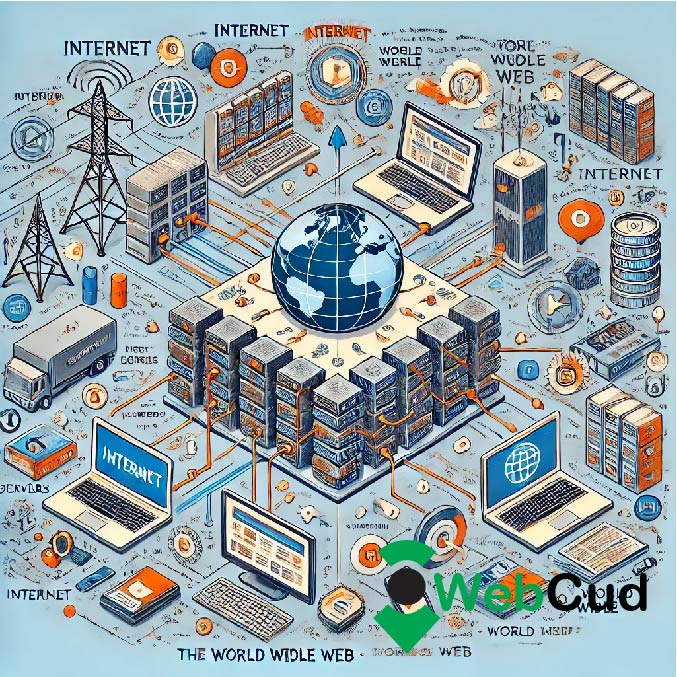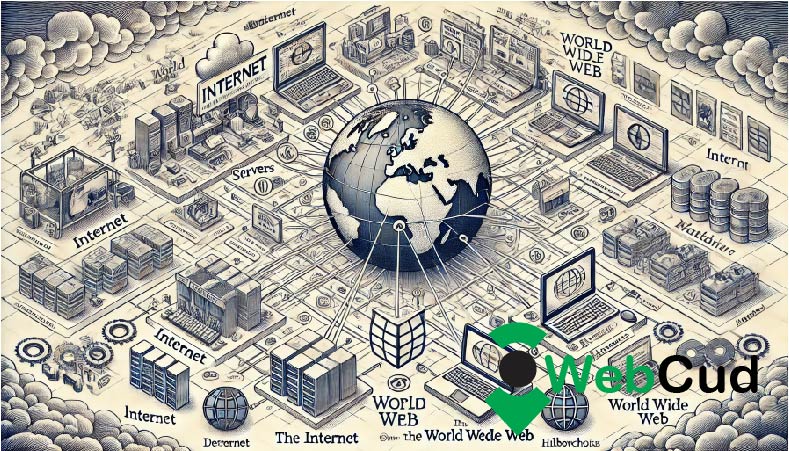Welcome to webcud! In this blog, we inform you of Understanding the Relationship Between the Internet and the World Wide Web. The Internet and the World Wide Web (WWW) are closely related but distinct concepts. Here’s a table that explains their relationship in detail.
| Aspect | Internet | World Wide Web |
|---|---|---|
| Definition | A global network of interconnected computers. | An information system on the Internet that allows documents to be connected by hyperlinks. |
| Components | Hardware (servers, routers, cables, etc.), protocols, and networks. | Websites, web pages, browsers, and hyperlinks. |
| Function | Facilitates data transfer and communication between computers worldwide. | Enables access and sharing of information through websites and web pages. |
| Scope | Broad and encompasses multiple services like email, FTP, and VoIP. | Narrower, focused specifically on accessing and linking documents via HTTP. |
| Creation | Developed in the late 1960s by ARPANET (Advanced Research Projects Agency Network). | Created by Tim Berners-Lee in 1989. |
| Primary Protocols | TCP/IP (Transmission Control Protocol/Internet Protocol). | HTTP/HTTPS (Hypertext Transfer Protocol/Secure). |
| Usage | Used for a variety of services including email, file sharing, and online gaming. | Used primarily for browsing, accessing, and sharing web pages and content. |
| Interdependence | The World Wide Web relies on the Internet to function. | |
| Analogy | Comparable to the physical infrastructure of roads and highways. | Comparable to the vehicles and destinations that use the roads. |

which of the following best explains the relationship between the internet and the world wide web?
Definition
- Internet: The Internet is a massive network of networks, connecting millions of private, public, academic, business, and government networks globally. It allows computers to communicate with each other.
- World Wide Web: The Web is a way of accessing information over the medium of the Internet.
Components
- Internet: Includes the physical infrastructure like servers, routers, cables, and the protocols (rules) for data transmission.
- World Wide Web: Comprises web pages, websites, web browsers, and the hyperlinks that connect them.
Function
- Internet: Its primary function is to facilitate data transfer and communication, enabling various services.
- World Wide Web: It functions as a system for accessing, linking, and sharing documents and multimedia.
Scope
- Internet: It is broad and includes multiple services like email (SMTP), file transfer (FTP), and Voice over IP (VoIP).
- World Wide Web: It is more focused on accessing documents and resources through web browsers using HTTP/HTTPS protocols.
Creation
- Internet: Originated in the late 1960s with the development of ARPANET.
Primary Protocols
- Internet: Uses TCP/IP protocols for data communication.
- World Wide Web: Uses HTTP/HTTPS protocols for transferring web pages and resources.
Usage
- Internet: Supports various applications and services beyond just the Web, including email, file transfers, and remote login.
- World Wide Web: Specifically used for browsing and accessing web content.
Interdependence
- World Wide Web: Cannot function without the Internet as it relies on it for connectivity and data transfer.
- Internet: Provides the essential infrastructure and connectivity that makes the Web possible.
Analogy
- Internet: Think of it as the infrastructure of roads and highways.
- World Wide Web: Think of it as the vehicles and destinations that utilize the roads to get from one place to another.
Conclusion
The Internet is the foundational technology that connects computers globally, while the World Wide Web is an application built on top of the Internet, allowing us to access and share information through websites and web pages. Understanding their relationship helps clarify how digital communication and information sharing work in today’s world.


Hey people!!!!!
Good mood and good luck to everyone!!!!!